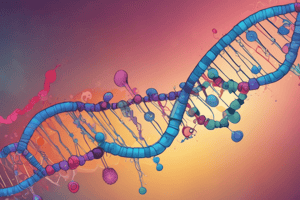Podcast
Questions and Answers
What is the role of Hfq in bacterial small RNA regulation?
What is the role of Hfq in bacterial small RNA regulation?
- Hfq promotes the degradation of sRNAs
- Hfq prevents sRNA from binding to mRNA targets
- Hfq inhibits the transcription of sRNAs
- Hfq helps sRNA bind mRNA target and stabilizes the binding (correct)
What happens when a riboswitch binds to S-adenosylmethionine (SAM)?
What happens when a riboswitch binds to S-adenosylmethionine (SAM)?
- It prevents the formation of riboswitch structures
- It causes rearrangements in the aptamer and expression platform, affecting gene expression (correct)
- It inhibits the binding of uncharged tRNAs
- It activates the translation of the gene transcript
How do riboswitches respond to metabolite binding?
How do riboswitches respond to metabolite binding?
- They exhibit protein-like structure diversity (correct)
- They prevent the formation of riboswitch structures
- They increase access to ribosome binding sites
- They block any further RNA Polymerase transcription of the transcript
What is the function of regulatory small RNAs (sRNAs) in bacteria?
What is the function of regulatory small RNAs (sRNAs) in bacteria?
How do bacterial small RNAs (sRNAs) affect mRNA translation?
How do bacterial small RNAs (sRNAs) affect mRNA translation?
Riboswitches are only found in eukaryotic cells.
Riboswitches are only found in eukaryotic cells.
Bacterial small RNAs (sRNAs) always repress levels of proteins and never promote them.
Bacterial small RNAs (sRNAs) always repress levels of proteins and never promote them.
Riboswitches can bind and respond to uncharged tRNAs.
Riboswitches can bind and respond to uncharged tRNAs.
Activated riboswitch structures always block further transcription or translation.
Activated riboswitch structures always block further transcription or translation.
Riboswitches exhibit limited structural diversity compared to proteins.
Riboswitches exhibit limited structural diversity compared to proteins.
Explain the regulatory roles of single stranded RNA in gene transcription and translation.
Explain the regulatory roles of single stranded RNA in gene transcription and translation.
Describe the function and mechanism of riboswitches in gene transcripts.
Describe the function and mechanism of riboswitches in gene transcripts.
How do bacterial small RNAs (sRNAs) regulate gene expression and mRNA translation?
How do bacterial small RNAs (sRNAs) regulate gene expression and mRNA translation?
Explain the mechanism of attenuation and its effect on RNA Pol transcription and ribosomal translation.
Explain the mechanism of attenuation and its effect on RNA Pol transcription and ribosomal translation.
How do riboswitches respond to metabolite binding and what are the different outcomes of metabolite binding to riboswitches?
How do riboswitches respond to metabolite binding and what are the different outcomes of metabolite binding to riboswitches?
Study Notes
Eukaryotic Promoters and Transcription Initiation
- Eukaryotic promoters contain subsets of four different sequences
- Prokaryotic σ factor replaced by many eukaryotic general transcription factors (GTFs) that assist RNA polymerase
- Prereplicative complex involves sequential TFII assembly followed by phosphorylation events
- Eukaryotic RNA polymerase II targeted by multiple protein kinases for promoter escape
Mediator Complexes and RNA Polymerase II Activity
- Multisubunit Mediator complexes generally needed for RNA polymerase activity
- RNA polymerase II phosphorylation serves as a switch between initiation and elongation
Elongation and Processing
- Elongation factor proteins accelerate RNA growth by stopping pauses (errors)
- FACT-mediated reversible histone removal and replacement keeps DNA packed and protected
- Proper elongation, termination, and processing require enzyme recruitment
- RNA capped early to protect transcript and ensure proper processing
- RNA 5’ capping needs GTP, S-adenosyl methionine (SAdoMet), and three sequential enzymes
- RNA’s poly-A tail partly encoded by DNA, RNA cleaved, and enzymes add extra A
Transcriptional Termination
- Transcriptional termination models differ in that one needs RNase (torpedo)
RNA Polymerase I and III
- RNA genes transcribing RNA polymerase I and III require specialized GTFs
Regulatory RNAs
- Regulatory RNAs exploit Watson-Crick base-pairing to other RNAs and DNAs, blocking binding and altering RNA structure
Studying That Suits You
Use AI to generate personalized quizzes and flashcards to suit your learning preferences.
Related Documents
Description
Test your knowledge of nucleic acids biochemistry, regulatory RNAs, and examples of prokaryotic and eukaryotic promoters with this quiz. Review the concepts of eukaryotic promoter sequences, the role of sigma factors and general transcription factors, as well as the process of pre-replicative complex assembly and promoter escape.




